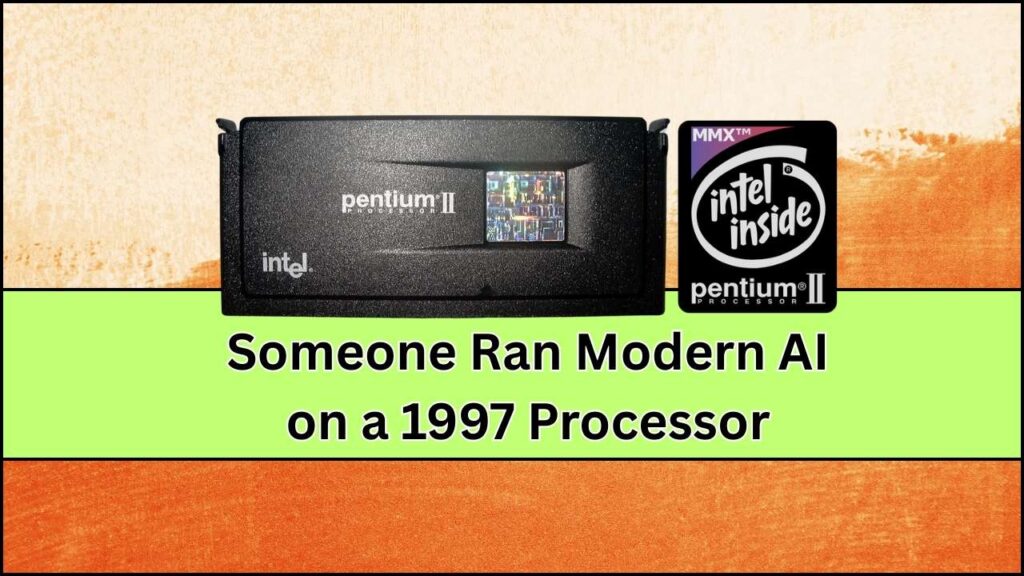Someone Ran Modern AI on a 1997 Processor: Imagine trying to run modern AI on a 1997 processor with just 128MB of RAM. That’s exactly what a team of computer enthusiasts from EXO Labs attempted – and the results are nothing short of fascinating.

In a world where we measure processing power in teraflops and memory in gigabytes, this experiment takes us back to the days of dial-up internet and floppy disks to test the true limits of retro technology.
What happens when you put a machine built before smartphones, cloud computing, or YouTube against the cutting edge of artificial intelligence? As it turns out, more than you’d expect – but with some serious limitations.
Someone Ran Modern AI on a 1997 Processor
| Topic | Details |
|---|---|
| Experiment Title | Running AI on Vintage Hardware (Pentium II, 128MB RAM) |
| Processor Used | Intel Pentium II (1997) |
| RAM Capacity | 128MB |
| Operating System | Windows 98 |
| AI Model Used | LLaMA 2 variant (260K & 15M parameter versions) |
| Performance | ~40 tokens/sec (260K), 1 token/sec (15M) |
| Limitations | No USB, FAT32 file system, limited software compatibility |
| Estimated Speed for LLaMA 3.2B | 0.0093 tokens/sec |
| Official Source | EXO Labs AI Blog |
Running modern AI on a 1997 processor is a brilliant look at how far technology has come. While not practical for real-world applications, it offers valuable insights into the importance of efficiency, resource management, and the sheer leap in computing capability over the past two decades.
In a world where bigger often means better, this experiment reminds us that sometimes small and simple can still be powerful – or at least educational. For hobbyists, educators, or AI pros looking to understand the roots of the field, this retro challenge is more than a gimmick – it’s a testament to the ingenuity behind modern computing.
How Did They Do It?
The team at EXO Labs started by purchasing a 25-year-old Windows 98 PC for around £119 (roughly $150). The system featured an Intel Pentium II processor, which was state-of-the-art in 1997, and 128MB of RAM, which even then was on the higher end.
The Setup: Challenges of Retro Tech
Getting the PC up and running was a challenge in itself. Here’s a quick breakdown:
- No functional USB ports, so modern external drives couldn’t be used.
- FAT32 file system couldn’t recognize their 4TB modern hard drive.
- PS/2 ports were needed for the keyboard and mouse.
- Software installation was tricky – they had to use FTP (File Transfer Protocol) to move files.
Despite these limitations, the team successfully connected the old PC to a local network and uploaded the necessary files to run a simplified version of an AI model.
Running AI on the Past: LLaMA 2 Comes to Life
They began by loading a 260,000-parameter version of Meta’s LLaMA 2 model. Despite the hardware constraints, the model was able to generate about 40 tokens per second, which is relatively fast given the context. For comparison, modern GPUs can generate thousands of tokens per second, depending on the model size.
Encouraged by this success, they tried a 15-million-parameter version, which ran much slower – at just 1 token per second. Attempting anything larger, like LLaMA 3 with billions of parameters, proved to be more of a theoretical exercise than a practical one.
Fun Fact:
If they tried running LLaMA 3.2B (3.2 billion parameters), the expected speed would be a glacial 0.0093 tokens per second. At that rate, it would take almost 2 minutes to generate just one word!
Why This Matters: A Lesson in Tech Evolution
This isn’t just a fun stunt. It shows how far we’ve come in computing power, software optimization, and AI accessibility. A $1,000 smartphone today vastly outperforms what once cost thousands of dollars in 1997.
Practical Insights:
- Model optimization matters. Choosing a smaller model allowed for basic AI functionality.
- Local inference on old hardware is possible – but not scalable.
- Hardware-software compatibility is critical in tech planning.
Professionals in AI development, cybersecurity, or edge computing might draw inspiration from this experiment. Could ultra-low-power AI become useful for embedded or IoT applications with tighter budgets?
Step-by-Step Breakdown for Enthusiasts
If you’re curious to try this (or just appreciate the nerdy challenge), here’s a simplified roadmap:
Step 1: Get the Hardware
- Source a Windows 98 machine with a Pentium II or similar.
- Ensure it has at least 128MB RAM and working PS/2 ports.
Step 2: Reconnect It to Modern Networks
- Install an Ethernet card if not present.
- Use FTP or serial connections to transfer files.
Step 3: Prepare the Software
- Use Miniconda or a lightweight Python build.
- Choose an ultra-compact LLM, such as a 260K or 1M parameter version.
- Simplify prompts and reduce compute load.
Step 4: Start the Model
- Run inference via command line.
- Monitor token speed output to track performance.
Step 5: Experiment and Analyze
- Try tweaking parameters, batch sizes, and prompt styles.
- Log performance and compare with modern systems.
Is There a Future for Tiny AI?
Yes. While this retro experiment was mostly for fun, tiny AI models are getting more attention. Use cases include:
- Offline AI assistants on older phones or embedded systems.
- Low-power edge AI for sensors and smart devices.
- Education and accessibility for learning environments with limited infrastructure.
Projects like TinyML and Edge Impulse are helping bring AI to minimal hardware in real-world applications.
Grok 3 AI Launch Begins – Will This Redefine Artificial Intelligence?
iOS 18.3 Sets the Stage for Apple Intelligence – The Big Moment Explained
FAQs About Someone Ran Modern AI on a 1997 Processor
Can you really run AI on old computers?
Yes, but with major performance tradeoffs. You need very small models, efficient code, and lots of patience.
What’s the smallest AI model available today?
Some models go as low as 100K parameters. These can handle basic tasks like text classification or keyword matching.
Is this useful for businesses?
Not directly, but it could inspire low-cost solutions in developing regions or for IoT use cases.
Can I do this at home?
Absolutely – if you’re comfortable with old tech and don’t mind tinkering. Just be prepared for a lot of troubleshooting.
What’s the biggest model you could realistically run?
Under these constraints, anything above 20 million parameters becomes extremely slow. Stick to the smallest models available.








